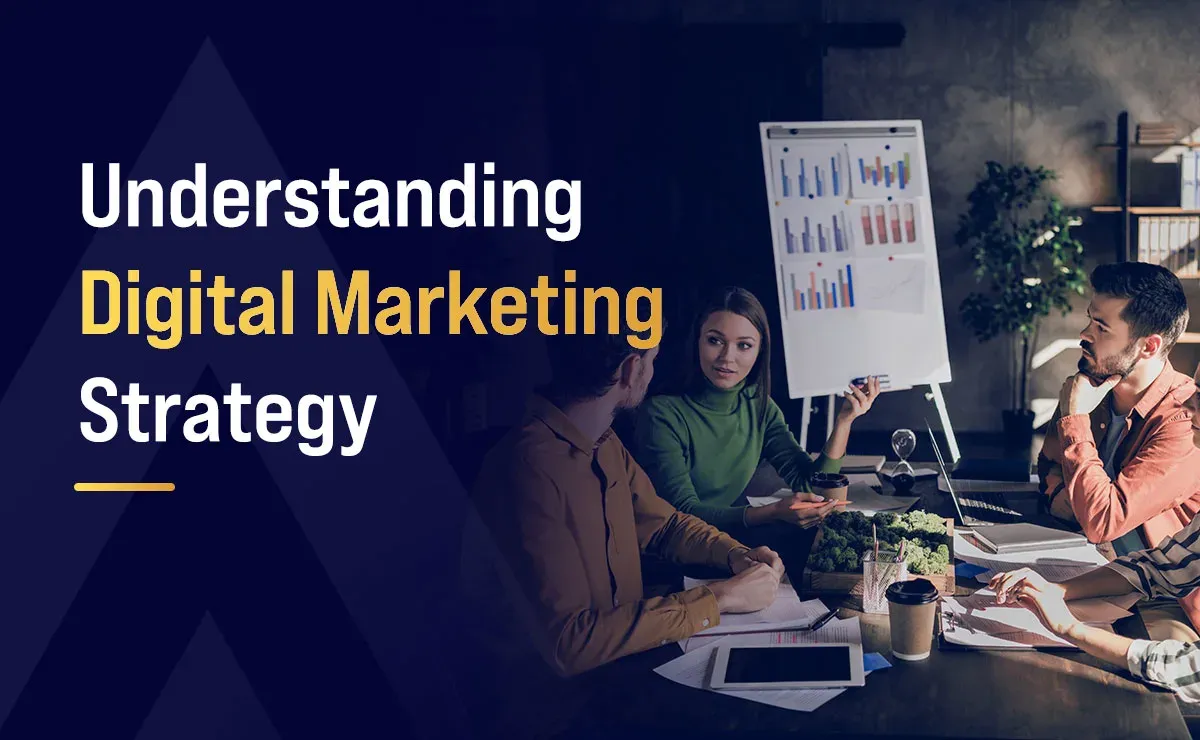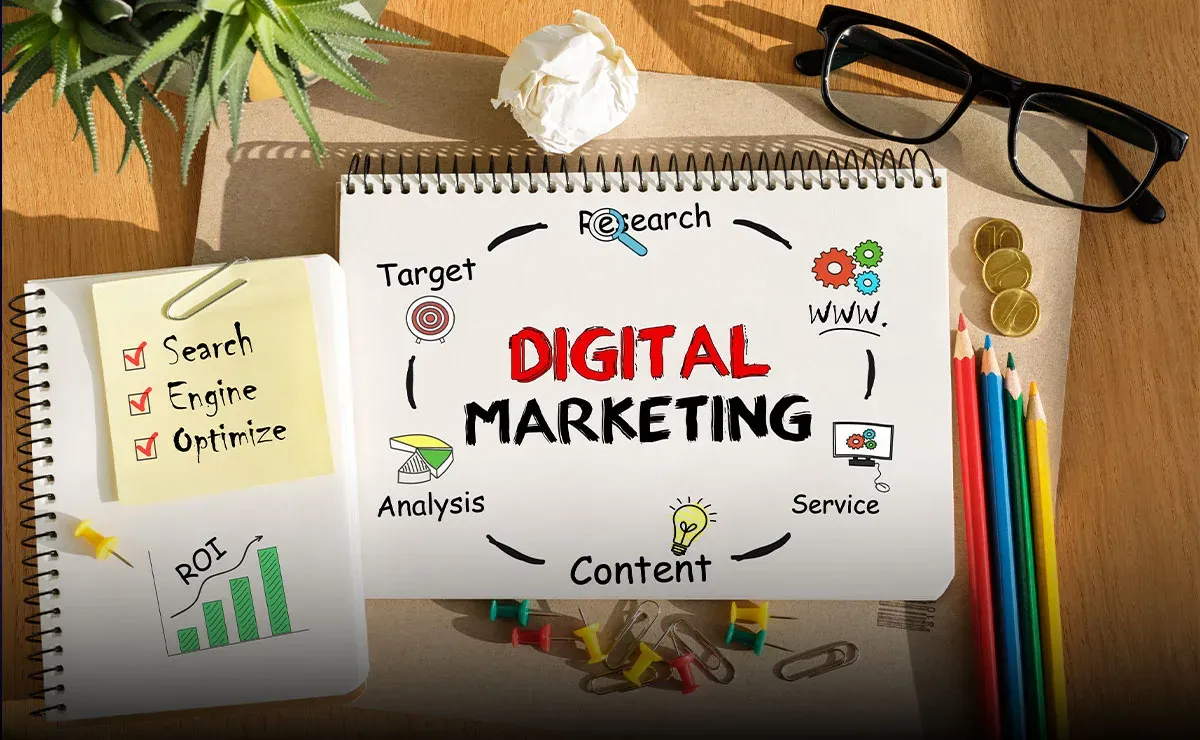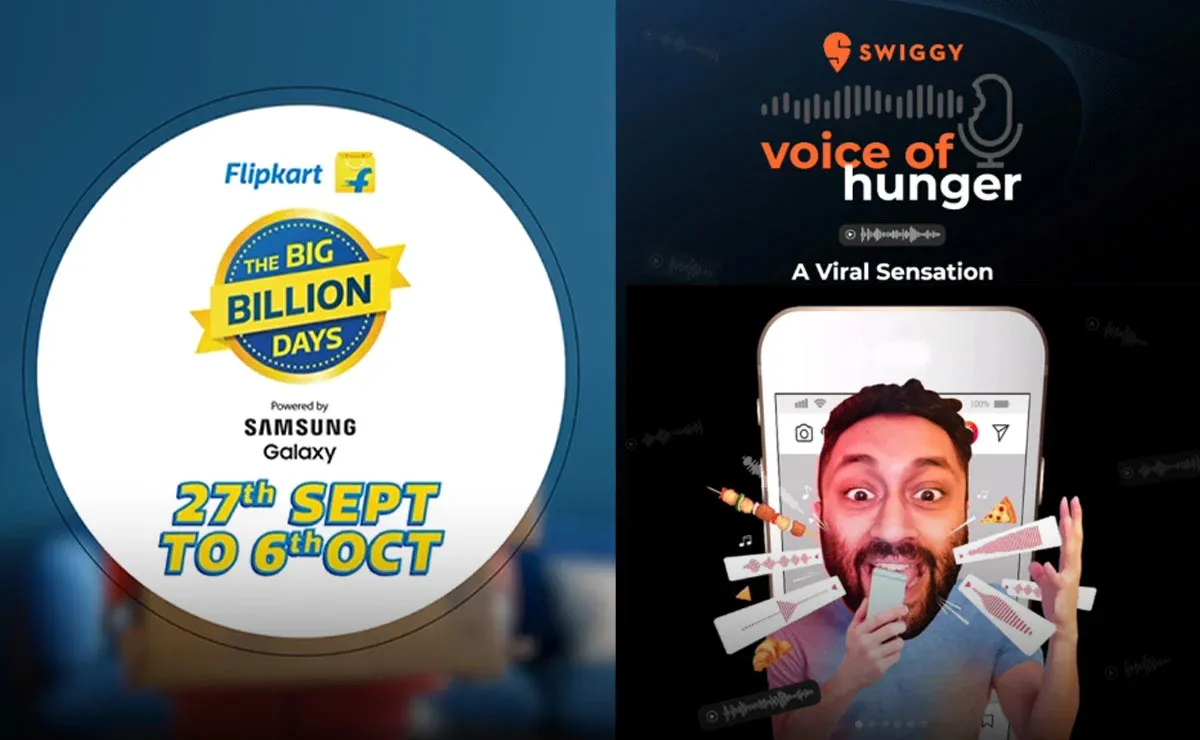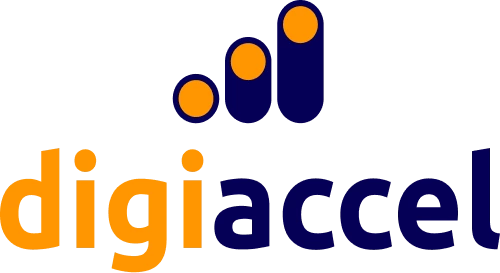Understanding Digital Marketing Strategy

Digital marketing strategy is a comprehensive plan that leverages digital channels to achieve business objectives, requiring data-driven insights, customer-centric approaches, and integrated campaigns across multiple platforms. In India's USD 5.15 Billion digital marketing landscape, successful strategies combine AI-driven personalization, regional content, and omnichannel experiences to capture the attention of 491 million active social media users.
Digital marketing in India has evolved from a supplementary channel to the dominant force in advertising, which will command 61% of total advertising spend by 2026 and is projected to reach ₹69,856 crore. With over 900 million internet users and 80.31% of web traffic coming from mobile devices, Indian businesses must craft sophisticated digital strategies to thrive in this dynamic ecosystem.
This article draws on established frameworks, industry research, and practical examples to explain what a digital marketing strategy is, how to build one, and which approaches deliver the best return.
What is a Digital Marketing Strategy?

A digital marketing strategy serves as a holistic plan detailing a company's approach to utilizing online platforms for meeting its promotional goals. It encompasses the systematic planning, execution, and optimization of marketing activities across various digital platforms to reach, engage, and convert target audiences into customers.
Digital marketing strategy integrates multiple touchpoints, including social media, search engines, email marketing, content platforms, and mobile applications, to create cohesive customer experiences. Strategies are different from tactics and campaigns, which are specific time-bound activities and efforts used to meet specific objectives. Strategy, on the other hand, sits above both and guarantees that campaigns and tactics work toward the same business outcomes.
According to the IBEF Report, "Digital marketing in India goes beyond a short-term trend; it signals a significant change that is reshaping the way businesses and communities interact."
Tips for Creating an Effective Digital Strategy
Here are a few proven principles that will improve the quality and impact of your strategy.
1) Understand Your Customer
No strategy will work without a deep understanding of who buys your product, why they buy it, and how they make decisions. Create data-driven buyer personas that capture role, company profile, goals, pain points, preferred information sources, and buying triggers. Combine analytics, CRM signals, customer interviews, and sales feedback to build realistic personas.
Action steps:
- Interview customers and conduct internal workshops with sales and support.
- Combine analytics, CRM signals, social listening, and interviews into persona profiles.
- Map each persona to their typical buying journey and the content they need at each stage.
- Localize messaging where cultural nuance matters.
Studies indicate that 78% of Indian shoppers consult online resources to research products before purchasing, rendering customer journey mapping a necessity.
2) Audit & Assess
A comprehensive digital audit provides the baseline for strategic planning. This involves evaluating current digital assets, competitive positioning, and market opportunities. Before investing in new channels, audit what you already own across owned, paid, and earned media.
Essential Audit Components:
- Website Performance: Loading speed, mobile optimization, and user experience.
- Content Quality: Relevance, engagement metrics, and SEO effectiveness.
- Social Media Presence: Follower engagement, content performance, and platform effectiveness.
- Competitor Analysis: Market positioning, strategy gaps, and opportunity identification.
- Technology Stack: Marketing automation tools, analytics platforms, and integration capabilities.
With digital marketing spending projected to grow at 30.2% CAGR between 2024 and 2032, regular audits ensure optimal resource allocation.
3) Focus on the End Result
Marketing is most effective when it focuses on the outcomes customers want rather than features. Hence, Digital marketing strategies must align with specific, measurable business outcomes. Emphasize the post purchase impact and real-world benefits of your product or service. Use case studies, customer journeys, and value calculators to demonstrate business outcomes.
Goal Setting Framework:
- Revenue Growth: Direct sales attribution and customer lifetime value.
- Brand Awareness: Indicators such as reach, impression counts, and brand recall measurements.
- Customer Acquisition: Cost per acquisition and conversion rates.
- Customer Retention: Engagement rates and repeat purchase behavior.
- Market Share: Competitive positioning and market penetration.
For example, 41% of marketers measure content marketing effectiveness through sales, emphasizing the importance of outcome-focused planning.
4) Review and Refine
Define KPIs that map to business objectives and create a regular review cadence. Avoid vanity metrics that look good but do not affect the bottom line. Use both leading indicators, such as engaged visits and conversion rate, and lagging indicators, such as revenue and customer lifetime value. Continuous optimization drives long-term success in digital marketing, making it a crucial factor.
Review Process Components:
- Performance Analytics: Monthly assessment of key performance indicators.
- Customer Feedback: Regular surveys and sentiment analysis.
- Competitive Monitoring: Market trend analysis and strategy adjustments.
- Technology Updates: Platform algorithm changes and feature adaptations.
- Strategy Iteration: Quarterly strategy refinements based on performance data.
What are the Most Effective Digital Marketing Strategies?
No single strategy fits every business; hence, it is important to choose the approaches that match your objectives, audience, and buying cycle. Below are the most reliable and widely used strategies and how to get the most from each.
1) Content Marketing
Content is the foundation of modern digital marketing, as it helps educate prospects, builds trust, and fuels SEO, social media, and email marketing success. Eighty-three percent of marketing professionals view content marketing as the foremost tactic for stimulating demand. They use a mix of long-form content, short articles, video explainers, webinars, and downloadable assets to help address customer questions at every stage of the funnel.
Content Marketing Performance Metrics:
- Brand Awareness: 87% of B2B marketers credit content marketing with building brand awareness.
- Lead Generation: Content initiatives produce triple the quantity of leads compared to conventional outreach efforts.
- Investment Growth: 46% of B2B marketers expect to increase content marketing budgets in 2025.
Best practices:
- Research intent and create content that answers real buyer queries.
- Prioritize quality and depth over quantity.
- Keep a consistent publication cadence and a documented content brief process.
- Identify which content assets drive new lead acquisition and intensify investment in those specific forms and subjects.
2) Social Media Marketing
Social media platforms amplify content, build community, and support targeted paid campaigns. It has reached an unprecedented scale in India, with 490+ million active users spending an average of 2.5 hours daily across platforms.
Platform Performance Statistics:
- Instagram Users: 230+ million in India.
- Facebook Users: 320+ million active users.
- YouTube Viewership: 460+ million users.
- Mobile Usage: Mobile platforms are projected to account for 83% of all social media advertising expenditure by 2029.
Best practices:
- Match content format to platform and audience. For instance, LinkedIn for B2B thought leadership and Instagram for visual storytelling.
- Use social listening to capture sentiment and content ideas.
- Test creative and copy variations to amplify what works with paid budgets.
- Measure community health over vanity metrics.
3) SEO (Search Engine Optimization)
SEO remains fundamental to digital success, as it helps optimize your website and content for the search engine so that it displays it to users who have relevant queries. Search Engine Optimization is vital for securing consistent, economical organic visits from individuals seeking your solutions. Google dominates with 98% of online searches in India as of October 2024, making SEO optimization crucial for visibility.
SEO Performance Indicators:
- Organic Traffic Value: Over 99% of organic traffic goes to page one listings.
- Lead Quality: Leads acquired via SEO possess a 14.6% conversion rate, vastly surpassing the 1.7% rate of outbound leads.
- Mobile Optimization: This is an imperative consideration, as mobile gadgets originate 80.31% of website visits in India.
- Voice Search Growth: Indian users employ voice search twice as often as the global average, according to google.
Best practices:
- Prioritize solving real user problems and intent, instead of just focusing on rankings.
- Keep content fresh and consolidated to avoid keyword cannibalization.
- Monitor technical health continuously and fix issues fast.
- Combine SEO with content and PR to earn links and visibility.
4) Paid Advertising
Paid advertising represents buying clicks, impressions, or actions on search engines, social platforms, and programmatic networks to generate faster results than organic channels alone. It demonstrates robust growth, with programmatic advertising leading innovation in targeting and personalization. Contemporary paid approaches are characterized by AI-powered advertisement targeting and the application of first-party data.
Paid Advertising Trends:
- Programmatic Growth: The expansion of programmatic advertising, utilizing artificial intelligence and instantaneous bidding.
- Video Advertising: Dominates with 27% of digital spend.
- CTV Advertising: Expected to reach ₹2,300-2,500 crores by 2025.
- Personalization: 75% of brands incorporate generative AI in strategies.
Best practices:
- Start with small tests, measure CPA, and scale winners.
- Use remarketing to recapture visitors who did not convert.
- Align ad creatives with landing page experience to maximize conversions.
- Use audience segmentation and lookalike modeling for smarter targeting.
5) Influencer Marketing
Influencer marketing has evolved into a sophisticated strategy. It is the process of partnering with creators and thought leaders to reach engaged niche audiences via authentic endorsements, co-created content, or event collaborations. When you want credibility, targeted audience access, or to humanize your brand quickly, influencer marketing acts as the best option.
Influencer Marketing Evolution:
- Micro-Influencer Preference: 1K-10K followers provide higher and more relatable engagement rates.
- Regional Reach: Local influencers offer businesses the opportunity to nurture cultural relevance and trust.
- Platform Diversity: Multi-platform strategies are becoming common, with businesses actively using platforms like Instagram and YouTube to collaborate with influencers.
Best practices:
- Choose influencers based on audience fit and engagement quality, not vanity follower counts.
- Agree on deliverables and approval workflows but allow creative freedom.
- Measure results and build a roster of reliable partners for scale.
6) Email Marketing
Email marketing is one of the most important digital marketing strategies, as it helps deliver personalized messages directly to subscribers to nurture relationships, drive activation, and increase retention. It can be used across the sales funnel for lead nurturing, onboarding, cross-selling, and re-engagement. Email is especially powerful in the privacy-first world because it relies on first-party data. It continues to demonstrate robust results, with projections indicating a 25% compound annual growth rate for the sector over the next five years.
Email Marketing Statistics:
- Effectiveness Rating: 44% of marketing professionals consider email as their most effective channel.
- Budget Allocation: Average 7.8% of total marketing spend is dedicated to email.
- Mobile Optimization: 41% of emails are viewed on mobile devices.
- Personalization Impact: Behavior-based emails show 60.7x higher conversion rates than broadcast emails.
Best practices:
- Collect first-party data ethically and use it to personalize messaging.
- Keep cadence relevant and expectations set when users subscribe.
- Use experimentation to improve subject lines, content, and CTAs.
- Monitor deliverability and maintain list hygiene.
Examples of Successful Digital Marketing Strategies

India's digital marketing landscape has witnessed remarkable campaigns that have redefined brand engagement and consumer connection. These success stories demonstrate how innovative thinking, cultural understanding, and strategic execution can create lasting impact in the competitive digital ecosystem.
1) Flipkart's Big Billion Days Sale
Flipkart's annual Big Billion Days has evolved into more than just a sale event—it has become a cultural phenomenon that captures the essence of India's festive shopping spirit. The 2024 edition exemplified this transformation, recording 33 crore user visits during Early Access and Day 1 combined, establishing new benchmarks for digital commerce engagement.
Campaign Components:
- Omnichannel Orchestration: Flipkart Integrated social media, influencer partnerships, and hyper-personalized email campaigns to ensure consistent messaging across touchpoints.
- Logistics Innovation: The "Flipkart Minutes" fast delivery service accounted for 25 percent of electronics sales in Mumbai and reached 40 percent of pin codes in Delhi, reinforcing convenience and reliability.
- Regional Reach: Strong demand emerged from Tier 2 and Tier 3 cities such as Medinipur, Hisar, Berhampore, Bankura, and Agartala, reflecting a broader market expansion.
- Platform Impact: Shopsy, the digital commerce initiative by Flipkart, saw a 70 percent increase in visits and nearly three times more transactions versus pre-festival periods.
Together these elements demonstrate a multi-dimensional strategy that blends marketing, operations, and user experience to redefine festive e-commerce.
2) Swiggy's "Voice of Hunger" Campaign
Swiggy's "Voice of Hunger" campaign exemplifies how technological innovation can create emotional marketing narratives. The campaign challenged users to create sound waveforms shaped like different food items using Instagram's audio note feature, blending creativity with user engagement in unprecedented ways.
Campaign Components:
- Interactive Participation: Swiggy saw more than 10,000 entries daily during the five-day challenge.
- Multi-Platform Amplification: Instagram activity extended across social, email, and influencer channels.
- Performance Outcomes: The initiative yielded a 30% growth in application installations and a 25% increase in orders placed.
- Brand Impact: It reinforced Swiggy's image of convenience and personalization, supporting loyalty.
- Scalable Model: The campaign created a repeatable template for future community-led campaigns.
The five-day challenge sustained interaction and helped build a community of engaged users contributing to brand storytelling.
Summing Up
A future-ready digital marketing strategy in India is defined by continuous data-driven iteration, customer-centric innovation, and omnichannel excellence. Brands that invest in localization, automation, and engaging content consistently outperform, creating enduring value in an increasingly mobile-first, competitive landscape.
The real winners harness strategic frameworks, actionable insights, and robust technology to convert engagement into tangible outcomes—whether that's revenue, retention, or brand advocacy.
Ultimately, the digital leaders of tomorrow will be those who not only keep pace with changing trends but actively shape them, setting higher standards in relevance, personalization, and trust.

